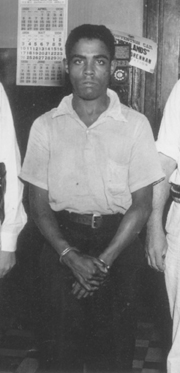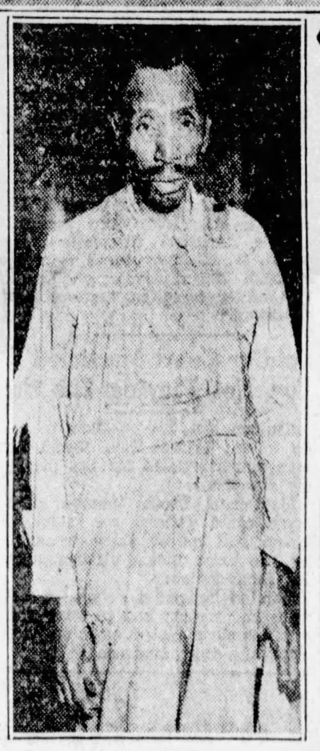Related Research Articles
Robbie James Lyons was convicted of the 1993 murder of Stephen Wilson Stafford and in 2003 was executed at Central Prison in Raleigh, North Carolina.

Rainey Bethea, was the last person publicly executed in the United States. Bethea, who confessed to the rape and killing of a 70-year-old woman named Lischia Edwards, was convicted of her rape and publicly hanged in Owensboro, Kentucky.

Capital punishment in Singapore is a legal penalty. Executions in Singapore are carried out by long drop hanging, and usually take place at dawn. Thirty-three offences—including murder, drug trafficking, terrorism, use of firearms and kidnapping—warrant the death penalty under Singapore law.

The Brownstone Lane murders were the mass murders of four people at a residence on Brownstone Lane in Houston, Texas. On June 20, 1992, three men tied up six people and shot all of them in the head execution-style. Four of the six victims died. The perpetrators: Marion Butler Dudley, Arthur "Squirt" Brown Jr., and Antonia "Tony" Lamone Dunson were convicted of capital murder. Dudley and Brown were sentenced to death, while Dunson was sentenced to life in prison.
The 1982 Wilkes-Barre shootings was a spree shooting which occurred in the United States on September 25, 1982, carried out by George Emil Banks, a former Camp Hill prison guard. Banks fatally shot 13 people in Wilkes-Barre and Jenkins Township, Pennsylvania. The victims included seven children – five being his own – their mothers, some of their relatives, and one bystander.

William C. Holman Correctional Facility is an Alabama Department of Corrections prison located in Atmore, Alabama. The facility is along Alabama State Highway 21, 9 miles (14 km) north of Atmore in southern Alabama.
Wrongful execution is a miscarriage of justice occurring when an innocent person is put to death by capital punishment. Cases of wrongful execution are cited as an argument by opponents of capital punishment, while proponents say that the argument of innocence concerns the credibility of the justice system as a whole and does not solely undermine the use of the death penalty.

Jay D. Scott was an American convicted murderer who was executed by the state of Ohio for the 1983 murder of a delicatessen owner in Cleveland. He was the second man put to death by Ohio since it reinstated capital punishment in 1981 and the first to be executed involuntarily. Scott's execution generated attention as he was diagnosed with schizophrenia, with his lawyers arguing he was too mentally ill to be executed.

Ángel Nieves Díaz was a Puerto Rican convict and a suspected serial killer who was executed by lethal injection by Florida. Nieves, who had escaped from a prison in Puerto Rico while serving time for murder, was convicted of shooting and killing the manager of a strip club in Florida in 1979. He maintained his innocence until his death.

Robert Wayne Williams was an American murderer convicted of the January 1979 murder of Willie Kelly, a 67-year-old security guard. He was executed in 1983 by the state of Louisiana by electric chair. He became the first person to be executed in Louisiana since 1976 when the death penalty was reinstated.
Capital punishment for juveniles in the United States existed until March 2, 2005, when the U.S. Supreme Court ruled it unconstitutional in Roper v. Simmons. Prior to Roper, there were 71 people on death row in the United States for crimes committed as juveniles.
Henry Ruhl was a spree killer and the only person executed in Wyoming by the U.S. government. This was also the second-to-last pre-Furman execution in the state and third-to-last as of 2022.

Ronnie Lee Gardner was an American criminal who received the death penalty for killing a man during an attempted escape from a courthouse in 1985, and was executed by a firing squad by the state of Utah in 2010. His case spent nearly 25 years in the court system, prompting the Utah House of Representatives to introduce legislation to limit the number of appeals in capital cases.
Chan Seng Onn is a Singaporean judge who presently serves as a Senior Judge of the High Court of Singapore. Formerly a prosecutor, Chan had previously served as a High Court judge from 2007 to 2022.

Asbury Respus was an American serial killer who confessed to at least eight murders throughout North Carolina and Virginia in the early 20th century. Respus was not a suspect in most of the murders he committed until he gave a lengthy confession during his trial for the murder of 9-year-old Vera Leonard, the murder for which he would be executed. Respus's victim profile was particularly unique in that his victims were not of a particular age or racial group, as four were white, four were black, two were children, and one was over 80 years old. Respus was executed in the electric chair at the Central Prison in Raleigh in 1932.

Freddie Eugene Owens alias Khalil Divine Black Sun Allah, was an American man convicted and executed in South Carolina for the 1997 killing of Irene Grainger Graves, a convenience store clerk. Owens was 19 when he and an 18-year-old accomplice shot and killed Graves during a robbery in November 1997.
References
- ↑ "Negro Fights Execution; Stands Off Armed Guard with Iron Bar". The Spokesman-Review. Associated Press. 29 April 1932. Retrieved 9 June 2014.
- ↑ Reference 3
- ↑ "Hold Three for Murder and Robbery in KY". Indianapolis Recorder. 18 April 1931. Retrieved 9 June 2014.
- ↑ Wright, George C. (1 March 1996). Racial Violence in Kentucky, 1865-1940: Lynchings, Mob Rule, and "Legal Lynchings". Baton Rouge, LA: Louisiana State University Press. pp. 276–277. ISBN 978-0807120736 . Retrieved 9 June 2014.
- ↑ "Negroes Given Death Penalty". Daily Illini. Associated Press. 2 May 1931. Retrieved 9 June 2014.
- ↑ "Grim Drama at Legal Killing of Negro Convicts". Oshkosh Daily Northwestern. Associated Press. 29 April 1932. Retrieved 9 June 2014.
- ↑ "Grim Drama Marks Deaths Three Negroes At Western State Prison In Kentucky". The Bristol News Bulletin. Associated Press. 29 April 1932. Retrieved 15 September 2021.
- ↑ "Doomed Man Routed from Cell by Gas". Hattiesburg American. Associated Press. 29 April 1932. Retrieved 9 June 2014.
- ↑ Reference 7
- ↑ Reference 1
- ↑ Reference 6
- ↑ Reference 4